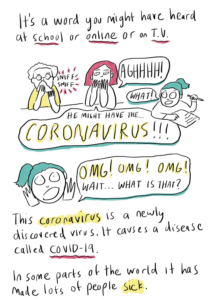— March 27, 2020 —
Days after a global pandemic upended life as we know it, my inbox filled with tips from parenting websites and my daughter’s school on how to talk to children about coronavirus. They were well-meaning of course, but here’s the thing: I’m not ready to talk to my five-year-old daughter about the virus.
Don’t get me wrong. I tried, at first.
I thought my daughter might feel unease about this topsy-turvy reality we’ve entered where handshakes are shunned, schools are closed, gatherings are banned, standing six feet apart is expected, teleworking is the new office, and staying at home is no longer for leisure, but mandated by the government.
Surely, I thought, my little kindergartner, who is on the autism spectrum, must be trying to make sense of it all. So, I printed the six-page social story her learning behavior specialist shared and sat down with her at our dining room table to read a tale titled, in all caps, “WHAT IS THE CORONAVIRUS?”
The story was developmentally and age-appropriate, illustrated with clip art of thermometers, microbes, and Funko Pop-faced little girls sweating and coughing as it explained symptoms, how to stay healthy (“I can help stop the spread of germs by washing my hands with soap and water”), and why schools were closed.
The story ended on a hopeful note: “Once the coronavirus is gone, I will be able to go to my favorite places again.”
Not that we made it to the ending. I lost my daughter’s attention somewhere around the second page when she began scripting lines from her favorite cartoon, “Doc McStuffins: Toy Hospital.”

If your child is under 6 like mine, you may not want to discuss the virus with them as it may introduce unnecessary anxiety, clinical psychologist Abi Gewirtz shared in a recent New York Times article. It’s prudent advice but sooner or later, especially as our children ask questions, we’ll need to educate them about things they may find scary, even when those same things scare us right now.
My first attempt to make my daughter aware of coronavirus, the virus that causes COVID-19, occurred on March 14, three days after the World Health Organization declared the viral outbreak—which at that time touched 114 countries and had killed more than 4,000 people—was officially a global pandemic.
I figured I’d try again when she was more attentive, but quickly decided not to take a second crack, for now. My decision boiled down to five words: let her have her childhood.
Sooner or later we’ll need to educate our children about things they may find scary, even when those same things scare us right now.
Last summer, two weeks before the start of kindergarten, I shared this observation about my daughter: “Her life is simple now, as it should be, filled with the little things that spark happiness: frilly dresses, Disney cartoons, magic wand bubbles, cuddle time, a pink bicycle with training wheels. She has no awareness of the headlines reflecting the troubled state of the world: mass shootings, white supremacist terror, trade wars, climate change, global inequality. Such concerns will inevitably creep into view as she moves through life but, for now, she’s cocooned in the bubble of childhood.”
I want my daughter to stay cocooned for just a bit longer.
As her father, I won’t always be there to protect her in this new age of COVID-19, but I can prevent anxiety from coloring her world by modeling calm in the storm, strength in the headwind, faith in the darkness.
I’d be lying if I didn’t admit to feeling anxious as our family hunkers down in our split-level home in Illinois under a stay-at-home order from the governor and braces for the worst as the daily number of confirmed COVID-19 cases in America ticks upward—along with its related deaths.
In the face of uncertainty, my wife and I strive to stick to our familiar family routine, never burdening our daughter with our concerns about what may come next for our loved ones, our friends, our country. I don’t mention coronavirus in chats with my daughter, focusing instead on how she can stay healthy and keep others around her healthy by practicing good hygiene.
For now, the bubble of childhood remains mostly intact.
To be clear, my daughter knows there’s been a shift in her daily life, but it doesn’t seem to bother her much just yet. She hasn’t asked when she’ll be able to see her friends, teacher or school staff again, but I know she misses them.
Weekday mornings, she still wakes up at her regular time, brushes her teeth, gets dressed and eats breakfast. My wife does her hair and drops her off at our daycare center, which remains open to the families of healthcare workers and employees deemed “essential” by the state.
From daycare, my daughter would normally board a bus for school. These days, that bus sits idle.
On the third morning of this daycare-only routine, my daughter asked to take her backpack. When we explained that she wouldn’t need it because school is closed, she whined. I thought she was upset because “no school “meant “no friends.” But as it turns out, she didn’t want her backpack at all, just the goodies inside: small canisters of her favorite snacks.
Children are more adaptable and resilient than we often give them credit for.
Nowadays, I still pick my daughter up from daycare, and she still has her at-home autism therapy sessions during the week. That means we still engage in her favorite in-the-car ritual: singing along to the 1976 classic “You’ll Never Find Another Love Like Mine” by soul crooner Lou Rawls.
My daughter sings with such gusto that she often closes her eyes to belt out the chorus:
Late in the midnight hour, baby (you’re gonna miss my lovin’)
When it’s cold outside (you’re gonna miss my lovin’)
You’re gonna miss, you’re gonna miss my lo-o-ove
(The video below depicts a typical car ride. My daughter hits her stride at the 2:03 mark.)
The coronavirus has paused many things about modern life.
It’s nice to be reminded that the carefreeness of childhood hasn’t been canceled.
Father on,

P.S. When I’m ready to talk to my daughter, I’ll try this kid-friendly comic (screenshot below) based on a radio story from NPR education reporter Cory Turner.

1167 words




One thought